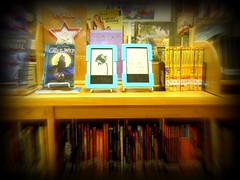Word clouds are simple to do, but effective. In the most basic sense, they involve taking text or a URL address, running it through a word cloud site, and magically beholding beautiful word art that makes the most frequently used words pop. They can typically be linked to, embedded in a blog or site, and displayed in a gallery. The apple on the upper right hand corner of this site is an example of a word cloud made on Tagxedo. Wave your cursor over the words to watch them enlarge. Go ahead. It’s fun.
So, how can word clouds fit into the classroom? Student use. Teacher use. Brainstorming. Previewing vocabulary. Analyzing your own writing, blog or website. A comparison of the “K” and the “L” in a KWL (Know, Want to Know, Learned). The list goes on and on. Check out some ideas and contribute your own to the LinoIt online sticky embedded below. (It is easiest to view and add to it HERE. Create a new sticky note. Use the hand to drag your sticky to a new place.)
Here are a few sites that generate word clouds: Tagxedo, Wordle, Tagul, and Wordlings. I listed Tagxedo and Wordle first because they are the two I use the most frequently. I particularly like Tagxedo because of all of the shape options it offers.
This Teacher Challenge blog post gives an overview of Wordle and some good example of how to use it. Here is a Google docs that gives 50 interesting ways to use Wordle in the classroom. This slideshare gives 101 suggestions for using Tagxedo. Here is a slideshare that shows how to use Tagul and describes some of its uses.

On the left is a Tagul word cloud I made using this blog. On the right is a Wordlings word cloud I made with this blog.
Go creative-crazy. Happy creating!


